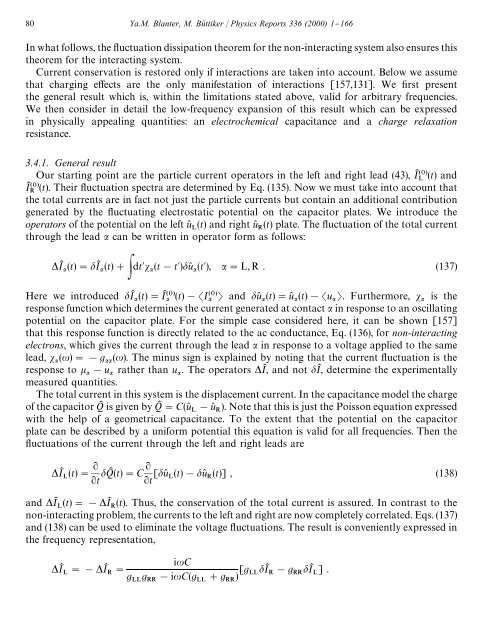shot noise in mesoscopic conductors - Low Temperature Laboratory
shot noise in mesoscopic conductors - Low Temperature Laboratory
shot noise in mesoscopic conductors - Low Temperature Laboratory
Create successful ePaper yourself
Turn your PDF publications into a flip-book with our unique Google optimized e-Paper software.
80 Ya.M. Blanter, M. Bu( ttiker / Physics Reports 336 (2000) 1}166<br />
In what follows, the #uctuation dissipation theorem for the non-<strong>in</strong>teract<strong>in</strong>g system also ensures this<br />
theorem for the <strong>in</strong>teract<strong>in</strong>g system.<br />
Current conservation is restored only if <strong>in</strong>teractions are taken <strong>in</strong>to account. Below we assume<br />
that charg<strong>in</strong>g e!ects are the only manifestation of <strong>in</strong>teractions [157,131]. We "rst present<br />
the general result which is, with<strong>in</strong> the limitations stated above, valid for arbitrary frequencies.<br />
We then consider <strong>in</strong> detail the low-frequency expansion of this result which can be expressed<br />
<strong>in</strong> physically appeal<strong>in</strong>g quantities: an electrochemical capacitance and a charge relaxation<br />
resistance.<br />
3.4.1. General result<br />
Our start<strong>in</strong>g po<strong>in</strong>t are the particle current operators <strong>in</strong> the left and right lead (43), IK (t)<br />
and<br />
<br />
IK (t).<br />
Their #uctuation spectra are determ<strong>in</strong>ed by Eq. (135). Now we must take <strong>in</strong>to account that<br />
<br />
the total currents are <strong>in</strong> fact not just the particle currents but conta<strong>in</strong> an additional contribution<br />
generated by the #uctuat<strong>in</strong>g electrostatic potential on the capacitor plates. We <strong>in</strong>troduce the<br />
operators of the potential on the left u( (t) and right u( (t) plate. The #uctuation of the total current<br />
<br />
through the lead can be written <strong>in</strong> operator form as follows:<br />
IK (t)"IK (t)# dt (t!t)u( (t), "L, R . (137)<br />
Here we <strong>in</strong>troduced IK (t)"IK <br />
(t)!I<br />
and u( (t)"u( (t)!u . Furthermore, is the<br />
<br />
response function which determ<strong>in</strong>es the current generated at contact <strong>in</strong> response to an oscillat<strong>in</strong>g<br />
potential on the capacitor plate. For the simple case considered here, it can be shown [157]<br />
that this response function is directly related to the ac conductance, Eq. (136), for non-<strong>in</strong>teract<strong>in</strong>g<br />
electrons, which gives the current through the lead <strong>in</strong> response to a voltage applied to the same<br />
lead, ()"!g (). The m<strong>in</strong>us sign is expla<strong>in</strong>ed by not<strong>in</strong>g that the current #uctuation is the<br />
<br />
response to !u rather than u . The operators IK , and not IK , determ<strong>in</strong>e the experimentally<br />
<br />
measured quantities.<br />
The total current <strong>in</strong> this system is the displacement current. In the capacitance model the charge<br />
of the capacitor QK is given by QK "C(u( !u( ). Note that this is just the Poisson equation expressed<br />
<br />
with the help of a geometrical capacitance. To the extent that the potential on the capacitor<br />
plate can be described by a uniform potential this equation is valid for all frequencies. Then the<br />
#uctuations of the current through the left and right leads are<br />
IK (t)"<br />
R R<br />
QK (t)"C<br />
Rt Rt [u( (t)!u( (t)] , (138)<br />
<br />
and IK (t)"!IK (t). Thus, the conservation of the total current is assured. In contrast to the<br />
non-<strong>in</strong>teract<strong>in</strong>g problem, the currents to the left and right are now completely correlated. Eqs. (137)<br />
and (138) can be used to elim<strong>in</strong>ate the voltage #uctuations. The result is conveniently expressed <strong>in</strong><br />
the frequency representation,<br />
iC<br />
IK "!IK "<br />
g g !iC(g #g )<br />
[g IK !g IK ].
















